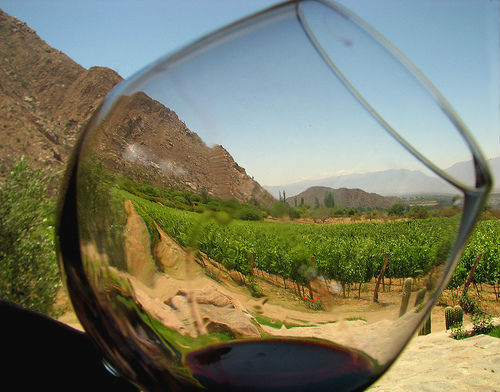Looking out from under the shade of an ancient Peumo tree, the view ahead of lush green vineyards framed by undulating hillsides could be anywhere in the Mediterranean – or perhaps even England on one of those rare, warm summer days. But it isn’t England, nor even Europe. This is Chile – at the far extremes of the globe, a country just hinged onto the edge of the South American content.
Irrespective of the angle from which you arrive in Chile, it feels remote and extreme. If you arrive from the north of the country, you have to cross a thousand kilometres of the world’s driest desert – the Atacama. With a sparse population of century-old cacti and hardy guanacos, it is a wild and extraordinary landscape, enjoyed by the privileged few who dare to wander into it.
Arriving in Chile from the east, you have to cross the towering Andes mountain range – only paralleled in height by the Himalayas. Imposing mountains create a sharp barrier from the rest of the continent and definitive frontier for Chile. Green, shrub-covered Andean foothills give way to bright red copper-rich rocks, smoking volcanoes, and at the very tippy top you get the teetering snow-caps and ice walls that form some of the most exhilarating mountaineering and ski spots in the world.
At the far south, the tail of Chile disappears in a wisp to the ice lands of Antarctica. Chilean Patagonia is a spellbinding kingdom of dark forests, silver-hued mountains, creaking glaciers and wide fjords. Giant spider crabs dwell in the freezing undercurrents and whales move upstream to find warmer waters for breeding.
Facing out towards the west, the horizon is equally as boundless. Beyond Chile lies the world’s largest ocean – the Pacific. With dramatic coastlines carved out along its 4270km length, Chile borders rough and cold Pacific waters that only begin to be tempered as they reach the shores of Polynesian islands some 8000km away.
Yet within these extreme perimeters lies a fertile oasis. It’s precisely because of its extreme edges that Chile is such a special place for agriculture and winemaking. The natural boundaries of desert, mountains, ice and sea mean that Chile is a virgin territory. When the worst disease in the history of wine, Phylloxera, swept over the globe, ravaging and destroying millions of vineyards the world over, Chile remained completely untouched. Sitting in a remote corner of the world, Chile is blissfully protected.
I feel protected – and quietly smug – sitting between the rolling hillsides in a balmy sunlit green basin of vineyards with a glass of red wine in hand. I’m in the middle of Colchagua – the heartland of Chilean wine. Known as the ‘central valleys’ of Chile, Colchagua and its connecting regions boast a warmer climate with long days of sunshine that are perfect for making supple and juicy red wines from Carmenere, Merlot and Syrah, as well as more tropical white wines like the aromatically explosive Viognier and Gewurztraminer.
This isn’t the only wine region in Chile though. There are the cool coastal regions of Limarí, Casablanca and San Antonio, whose vines are bathed in sea mist each morning and cooled by sea breeze each afternoon. The conditions are perfect for zesty Sauvignon Blanc, steely Chardonnay and electric Syrah.
It’s the hills of Aconcagua, Maipo and Cachapoal, whose vineyards creep up the side of the Andes Mountains reaching cooler temperatures and unadulterated sunlight, that make Chile’s famed Cabernet Sauvignon. And further south there’s the most historical of Chile’s wine regions – Maule, Itata and Bio Bio – where the old vines create magnificently balanced wines including Riesling, Pinot Noir, Carignan and Cinsault.
In my glass right now though, is a blend: an artist’s palate of Chile’s many terroirs, a bright painting of Chile’s diversity, and a sensorial pool of wine hand-picked from different sites around this unique country.
Yes, glass of wine in hand, I’m feeling quite smug indeed…
